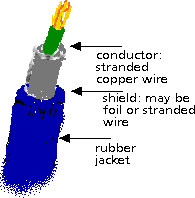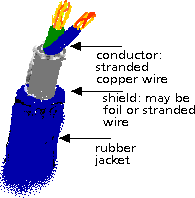| Typically
a stranded copper conductor in a rubber jacket with continuous copper or
aluminum, stranded or foil shield. One
conductor per channel; stereo cables will often share shield.
In some applications
there is a separate ground cable, though often the shield will be used
as ground. Jacket
thickness and flexibility will depend on application: typically thick and
flexible for microphone cable or guitar
cords, thinner for installations where the cable will not be moved. Conductor
size ranges from very small - no. 24 - 30 (as in earphone cable) to large
(no. 18 - 24) guitar and mic cable. For comparison, standard lamp
cord is no. 16 - 18 while cable used to plug in heaters might be no. 12
or no. 14. Speaker cable is generally unshielded. Long cable runs
will attenuate high frequencies. High fidelity systems designers
tend to use as thick a conductor as possible for speaker cable, the idea
being that this will minimize any conductive loss. No. 2 - 8 are not uncommon
sizes - close to the diameter of an adult little finger! |

